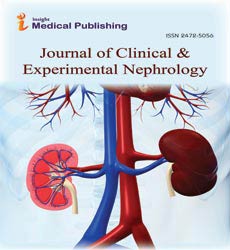Peritoneal Dialysis: A Personalized and Patient-Centered Approach to Kidney Care
Nian Alan*
Department of Nephrology, University of Chinese Medicine, Nanjing, China
Published Date: 2024-10-17DOI10.36648/2472-5056.9.5.272
Nian Alan*
Department of Nephrology, University of Chinese Medicine, Nanjing, China
- *Corresponding Author:
- Nian Alan
Department of Nephrology, University of Chinese Medicine, Nanjing,
China,
E-mail: alan_n@gmail.com
Received date: September 16, 2024, Manuscript No. IPJCEN-24-19837; Editor assigned date: September 19, 2024, PreQC No. IPJCEN-24-19837 (PQ); Reviewed date: October 03, 2024, QC No. IPJCEN-24-19837; Revised date: October 10, 2024, Manuscript No. IPJCEN-24-19837 (R); Published date: October 17, 2024, DOI: 10.36648/2472-5056.9.5.272
Citation: Alan N (2024) Peritoneal Dialysis: A Personalized and Patient-Centered Approach to Kidney Care. J Clin Exp Nephrol Vol.9 No.5: 272.
Description
Peritoneal Dialysis (PD) is a widely accepted and effective form of renal replacement therapy for patients suffering from End-Stage Renal Disease (ESRD). It offers an alternative to traditional hemodialysis by allowing patients to manage their treatment at home, thus providing a level of independence and flexibility that is unmatched in clinical settings. In this commentary, we will explore the key benefits, challenges and future prospects of PD, emphasizing its role as a patientcentered solution to kidney care. Peritoneal dialysis works by utilizing the patient’s peritoneal membrane as a filter. A dialysis solution, or dialysate, is introduced into the peritoneal cavity through a catheter. The peritoneal membrane acts as a semipermeable layer, allowing waste products and excess fluid from the blood to pass into the dialysate. After a prescribed dwell time, the dialysate is drained and replaced with a fresh solution, thus facilitating the continuous removal of toxins from the body.
Peritoneal dialysis
Continuous Ambulatory Peritoneal Dialysis (CAPD) involves manual exchanges of dialysate throughout the day, while APD uses a machine (cycler) to perform the exchanges during the night while the patient sleeps. Both modalities allow patients to avoid the repetitive hospital visits required for hemodialysis. One of the primary advantages of PD is the flexibility it offers to patients. Since PD can be performed at home, it allows patients to maintain a more normal routine without the need for regular visits to dialysis centers. This autonomy is especially valuable for those with work, family, or personal commitments. Patients can customize their treatments to suit their lifestyle, leading to better overall quality of life. PD is associated with fewer fluctuations in blood pressure and volume compared to hemodialysis. Hemodialysis subject’s patients to large shifts in fluid balance, which can be taxing on the heart and circulatory system. PD, on the other hand, allows for continuous fluid removal, reducing the risk of hypertension and cardiovascular complications, which are prevalent in dialysis patients. PD is known to better preserve residual kidney function compared to hemodialysis. The residual renal function plays a critical role in maintaining a better quality of life for patients with ESRD, as it aids in the clearance of toxins and fluid regulation. Patients on PD often experience slower decline in their remaining kidney function, which can prolong the time before they need a kidney transplant. Due to the continuous removal of waste and fluid in PD, patients typically face fewer dietary restrictions than those on hemodialysis. PD patients can enjoy a more liberal diet, particularly when it comes to potassium and fluid intake, which can greatly improve their nutritional status and overall well-being.
Innovations in peritoneal dialysis
The disruption of mineral metabolism in Chronic Kidney Disease (CKD) is associated with a range of complications, including renal osteodystrophy, vascular calcification and increased mortality. Therefore, managing mineral metabolism is a cornerstone of CKD treatment. Nephrologists must navigate a complex therapeutic landscape that includes phosphate binders, vitamin D analogs, calcimimetics and dietary modifications to maintain mineral balance. Phosphate binders are often prescribed to reduce phosphate absorption in the intestines, thereby lowering serum phosphate levels. These binders come in various forms, including calcium-based, non-calcium-based and iron-based agents, each with its own benefits and potential risks. The choice of binder is individualized based on the patient's overall health, serum calcium levels and risk of vascular calcification. Vitamin D analogs are used to replenish calcitriol levels and reduce PTH secretion. However, care must be taken to avoid hypercalcemia, which can lead to further complications. Calcimimetics, which increase the sensitivity of the parathyroid gland to calcium, are another option for controlling Para Thyroid Harmone (PTH) levels in patients with severe secondary hyperparathyroidism. Dietary management is also patients with CKD must often limit their intake of phosphate rich foods to prevent further disruption of mineral metabolism. This can be challenging, as phosphate is present in many foods, including dairy products, nuts, seeds and processed foods. Patients need to work closely with dietitians to ensure they receive adequate nutrition while managing their phosphate intake. While CKD provides a clear example of the challenges associated with mineral metabolism, it is essential to recognize that disruptions in mineral balance can affect individuals without kidney disease as well. Conditions such as osteoporosis, cardiovascular disease and certain endocrine disorders are also linked to mineral metabolism. This underscores the importance of understanding mineral metabolism not just in nephrology, but across various medical specialties.
Mineral metabolism is a complex, multifaceted process with far-reaching implications for health. For nephrologists, understanding and managing this delicate balance is critical to preventing complications in patients with CKD. However, the importance of mineral metabolism extends beyond nephrology, influencing a wide range of physiological processes and medical conditions. Continued research and a multidisciplinary approach are essential to advancing our understanding of mineral metabolism and improving patient care across the healthcare spectrum.
Open Access Journals
- Aquaculture & Veterinary Science
- Chemistry & Chemical Sciences
- Clinical Sciences
- Engineering
- General Science
- Genetics & Molecular Biology
- Health Care & Nursing
- Immunology & Microbiology
- Materials Science
- Mathematics & Physics
- Medical Sciences
- Neurology & Psychiatry
- Oncology & Cancer Science
- Pharmaceutical Sciences
